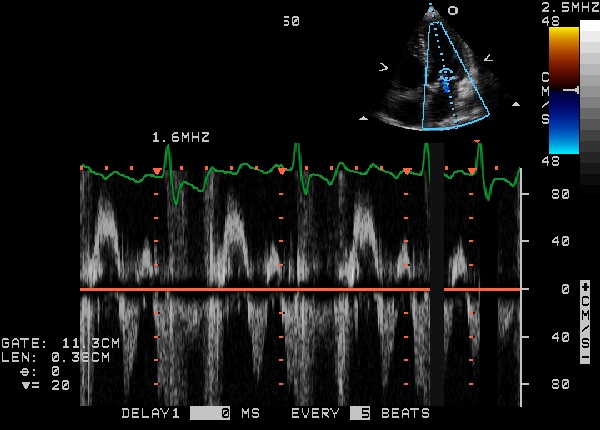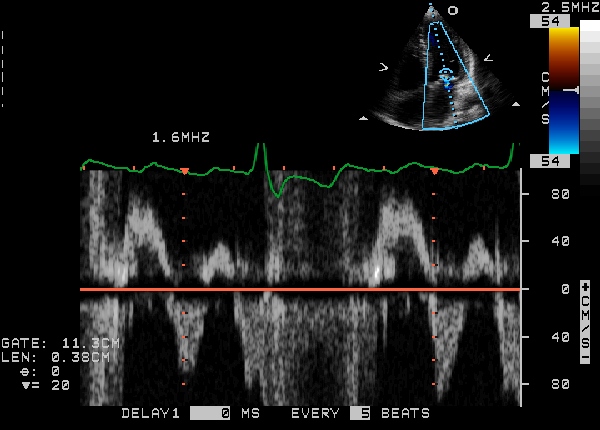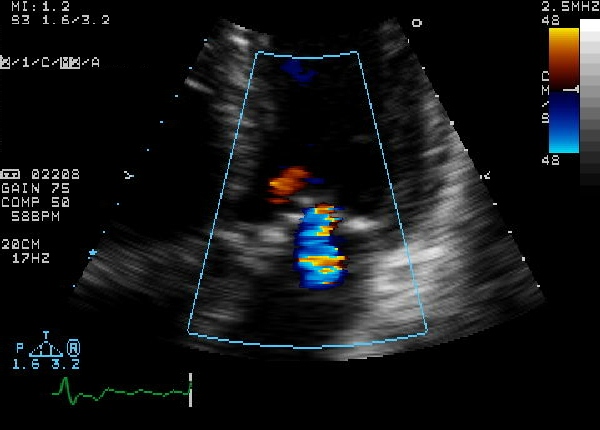Mitral regurgitation assessment of severity
Editor-In-Chief: C. Michael Gibson, M.S., M.D. [1]
Associate Editor-In-Chief: Cafer Zorkun, M.D., Ph.D. [2]; Varun Kumar, M.B.B.S.; Lakshmi Gopalakrishnan, M.B.B.S.
Colour flow mapping
- Size of flow recruitment is noted
- Jet base width at the valve level
- Intra atrial jet area if it is a central jet
- Jet direction is usually away from a prolapsing leaflet and behind a restricted leaflet
Continuous wave doppler
- Shape and density of signal - In severe Mitral regurgitation, the flow is dense and triangular
- If as dense as forward flow, it is severe.
Pulse wave doppler(PW)
- PW in apical-4-chamber view
- E wave more than 1.2m/s indicates severe MR
- Even minor mitral stenosis or hyperdynamic circulation can increase E wave
- If A-wave dominant, severe MR is virtually ruled out.
vena contracta
- vena contracta is the narrowest region of regurgitant jet (usually just below the valve in LA)
- >0.7 cm - severe MR
Pulmonary Venous Flow
- usually forward throughout cycle
- systolic dominant
- as MR worsens, there is a blunting of systolic flow
- If severe MR - systolic flow reversal.
Regurgitant volume
- Mitral regurgitant volume = Mitral inflow volume - LV outflow volume
- Mitral inflow volume = Vti * Cross sectional area of mitral valve
- LV outflow volume = Vti * Cross sectional area at LV outflow
- Regurtitant volume - <20% - mild , >50% severe
PISA (Proximal isovelocity surface area)
The radius of Proximal isovelocity surface area or flow convergence zone which is a 3-dimensional surface area proximal to a narrowed orifice at which all the blood velocities are equal, can be used to calculate the severity of mitral regurgitation. The principle is that if the mitral regurgitation is mild, only the blood nearer to the valve orifice accelerates towards the atrium while in severe regurgitation, blood farther away from the valve moves back.
PISA radius
A simple method to determine severity of mitral regurgitation is to measure the PISA radius. Regurgitation is mild if radius is <0.4 cm and severe if >1 cm.
Regurgitant flow (instantaneous)
The instantaneous regurgitant flow can be calculated from the PISA radius and can be used to assess the severity of mitral regurgitation.
Regurgitant flow = 2π * r2 * Valiasing
Effective regurgitant orifice area (EROA)
Effective regurgitant orifice area can be calculated using the instantaneous regurgitant flow. The formula can be derived from the following:
Valiasing * 2πr2 = Vmax * EROA
hence:
- EROA = PISA (2πr2) * Valiasing / Vmax
Mild = 0-20 cm2, moderate = 20 - 40 cm2, severe = >40 cm2
Regurgitant volume can be calculated from this.
- Regurgitant volume = Effective regurgitant orifice area * Vtime integrale
Diastolic Mitral Regurgitation Secondary to Severe Aortic Stenosis



<googlevideo>424719160215823743&hl=en</googlevideo>
<googlevideo>-1316686479831791521&hl=en</googlevideo>